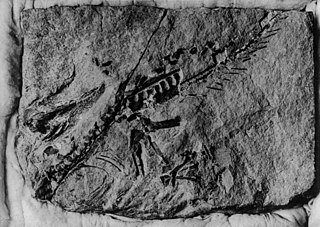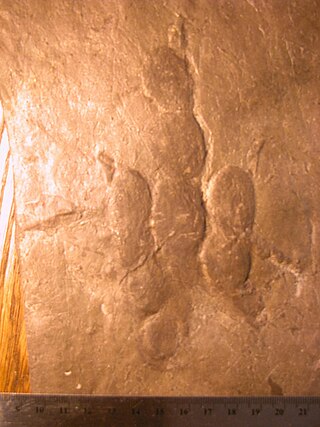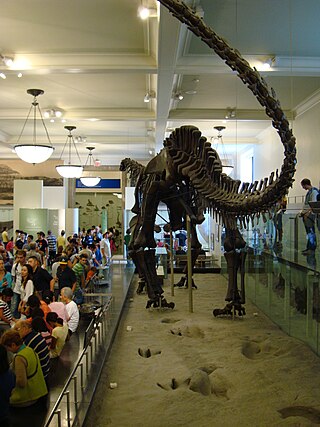
"Rauisuchia" is a paraphyletic group of mostly large and carnivorous Triassic archosaurs. Rauisuchians are a category of archosaurs within a larger group called Pseudosuchia, which encompasses all archosaurs more closely related to crocodilians than to birds and other dinosaurs. First named in the 1940s, Rauisuchia was a name exclusive to Triassic archosaurs which were generally large, carnivorous, and quadrupedal with a pillar-erect hip posture, though exceptions exist for all of these traits. Rauisuchians, as a traditional taxonomic group, were considered distinct from other Triassic archosaur groups such as early dinosaurs, phytosaurs, aetosaurs, and crocodylomorphs.
Phytosaurs are an extinct group of large, mostly semiaquatic Late Triassic archosauriform reptiles. Phytosaurs belong to the order Phytosauria. and are sometimes referred to as parasuchians. Phytosauria, Parasuchia, Parasuchidae, and Phytosauridae have often been considered equivalent groupings containing the same species. Some recent studies have offered a more nuanced approach, defining Parasuchidae and Phytosauridae as nested clades within Phytosauria as a whole. Phytosaurs were long-snouted and heavily armoured, bearing a remarkable resemblance to modern crocodilians in size, appearance, and lifestyle, as an example of convergence or parallel evolution. The name "phytosaur" means "plant reptile", as the first fossils of phytosaurs were mistakenly thought to belong to plant eaters.

Aetosaurs are heavily armored reptiles belonging to the extinct order Aetosauria. They were medium- to large-sized omnivorous or herbivorous pseudosuchians, part of the branch of archosaurs more closely related to crocodilians than to birds and other dinosaurs. All known aetosaurs are restricted to the Late Triassic, and in some strata from this time they are among the most abundant fossil vertebrates. They have small heads, upturned snouts, erect limbs, and a body ornamented with four rows of plate-like osteoderms. Aetosaur fossil remains are known from Europe, North and South America, parts of Africa, and India. Since their armoured plates are often preserved and are abundant in certain localities, aetosaurs serve as important Late Triassic tetrapod index fossils. Many aetosaurs had wide geographic ranges, but their stratigraphic ranges were relatively short. Therefore, the presence of particular aetosaurs can accurately date a site in which they are found.

Ornithosuchus is an extinct genus of pseudosuchians from the Late Triassic (Carnian) Lossiemouth Sandstone of Scotland. It was originally thought to be the ancestor to the carnosaurian dinosaurs, but it is now known to be more closely related to crocodilians than to dinosaurs.

Grallator ["GRA-luh-tor"] is an ichnogenus which covers a common type of small, three-toed print made by a variety of bipedal theropod dinosaurs. Grallator-type footprints have been found in formations dating from the Early Triassic through to the early Cretaceous periods. They are found in the United States, Canada, Europe, Australia, Brazil and China, but are most abundant on the east coast of North America, especially the Triassic and Early Jurassic formations of the northern part of the Newark Supergroup. The name Grallator translates into "stilt walker", although the actual length and form of the trackmaking legs varied by species, usually unidentified. The related term "Grallae" is an ancient name for the presumed group of long-legged wading birds, such as storks and herons. These footprints were given this name by their discoverer, Edward Hitchcock, in 1858.

Poposaurus is an extinct genus of pseudosuchian archosaur from the Late Triassic of the southwestern United States. It belongs to the clade Poposauroidea, an unusual group of Triassic pseudosuchians that includes sail-backed, beaked, and aquatic forms. Fossils have been found in Wyoming, Utah, Arizona, and Texas. Except for the skull, most parts of the skeleton are known. The type species, P. gracilis, was described and named by Maurice Goldsmith Mehl in 1915. A second species, P. langstoni, was originally the type species of the genus Lythrosuchus. Since it was first described, Poposaurus has been variously classified as a dinosaur, a phytosaur, and a "rauisuchian".

A fossil track or ichnite is a fossilized footprint. This is a type of trace fossil. A fossil trackway is a sequence of fossil tracks left by a single organism. Over the years, many ichnites have been found, around the world, giving important clues about the behaviour of the animals that made them. For instance, multiple ichnites of a single species, close together, suggest 'herd' or 'pack' behaviour of that species.

Mastodonsaurus is an extinct genus of temnospondyl amphibian from the Middle Triassic of Europe. It belongs to a Triassic group of temnospondyls called Capitosauria, characterized by their large body size and presumably aquatic lifestyles. Mastodonsaurus remains one of the largest amphibians known, and may have exceeded 6 meters in length.
Apatopus is an ichnogenus, or a name based on footprints, that may have been from a phytosaur. The trackmaker lived in the early Triassic. It was named by Baird in 1957.

Smok is an extinct genus of large carnivorous archosaur. It lived during the latest Triassic period. Its remains have been found in Lisowice, southern Poland. The only species is Smok wawelski and was named in 2012. It is larger than any other known predatory archosaur from the Late Triassic or Early Jurassic of central Europe. The relation of Smok to other archosaurs has not yet been thoroughly studied; it may be a rauisuchid, prestosuchid, an ornithosuchid pseudosuchian or a theropod dinosaur.

The Tensleep Sandstone is a geological formation of Pennsylvanian to very early Permian age in Wyoming.
The Bromsgrove Sandstone is a geologic formation of the Sherwood Sandstone Group in England. It preserves fossils and ichnofossils of Chirotherium barthii, and Chirotherium sickleri, dating back to the Middle Triassic (Anisian) period.

The 20th century in ichnology refers to advances made between the years 1900 and 1999 in the scientific study of trace fossils, the preserved record of the behavior and physiological processes of ancient life forms, especially fossil footprints. Significant fossil trackway discoveries began almost immediately after the start of the 20th century with the 1900 discovery at Ipolytarnoc, Hungary of a wide variety of bird and mammal footprints left behind during the early Miocene. Not long after, fossil Iguanodon footprints were discovered in Sussex, England, a discovery that probably served as the inspiration for Sir Arthur Conan Doyle's The Lost World.

The 19th century in ichnology refers to advances made between the years 1800 and 1899 in the scientific study of trace fossils, the preserved record of the behavior and physiological processes of ancient life forms, especially fossil footprints. The 19th century was notably the first century in which fossil footprints received scholarly attention. British paleontologist William Buckland performed the first true scientific research on the subject during the early 1830s.
This article records new taxa of trace fossils of every kind that are scheduled to be described during the year 2019, as well as other significant discoveries and events related to trace fossil paleontology that are scheduled to occur in the year 2019.
Gwyneddichnium is an ichnogenus from the Late Triassic of North America and Europe. It represents a form of reptile footprints and trackways, likely produced by small tanystropheids such as Tanytrachelos. Gwyneddichnium includes a single species, Gwyneddichnium major. Two other proposed species, G. elongatum and G. minore, are indistinguishable from G. major apart from their smaller size and minor taphonomic discrepancies. As a result, they are considered junior synonyms of G. major.

Bellatoripes is an ichnogenus of footprint produced by a large theropod dinosaur so far known only from the Late Cretaceous of Alberta and British Columbia in Canada. The tracks are large and three-toed, and based on their size are believed to have been made by tyrannosaurids, such as Albertosaurus and Daspletosaurus. Fossils of Bellatoripes are notable for preserving trackways of multiple individual tyrannosaurids all travelling in the same direction at similar speeds, suggesting the prints may have been made by a group, or pack, of tyrannosaurids moving together. Such inferences of behaviour cannot be made with fossil bones alone, so the record of Bellatoripes tracks together is important for understanding how large predatory theropods such as tyrannosaurids may have lived.

Protochirotherium, also known as Protocheirotherium, is a Late Permian?-Early Triassic ichnotaxon consisting of five-fingered (pentadactyl) footprints and whole tracks, discovered in Germany and later Morocco, Poland and possibly also Italy. The type ichnospecies is P. wolfhagenense, discovered by R. Kunz in 1999 alongside Chirotherium tracks, was named and described in 2004 and re-evaluated in 2007; a second ichnospecies, P. hauboldi, also exists, which was initially described as an ichnospecies of Brachychirotherium. Protochirotherium-like prints have also been documented from the Late Permian of Italy, possibly representing the oldest known fossils of mesaxonic archosauromorphs.

Dimetropus is a reptile ichnogenus commonly found in assemblages of ichnofossils dating to the Permian to Triassic in Europe and North America. Analysis of trackways of Dimetropus provides evidence that the tracks were left by diadectids or non-therapsid synapsids ("pelycosaurs").
Batrachichnus is an amphibian ichnogenus commonly found in assemblages of ichnofossils dating to the Mississippian to Triassic of North America, South America, and Europe. The animal producing the tracks was likely a temnospondyl. B. slamandroides is the smallest known tetrapod footprint, produced by an animal with an estimated body length of just 8 millimeters (0.31 in)
















